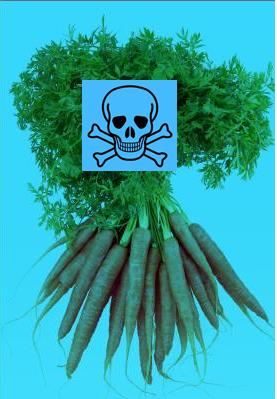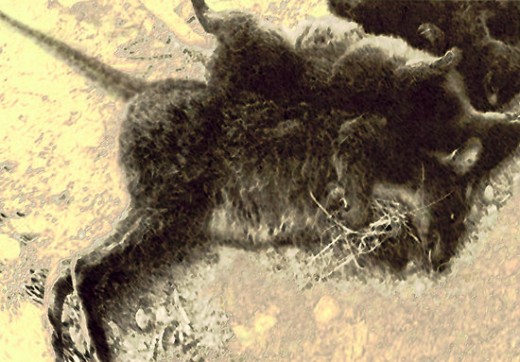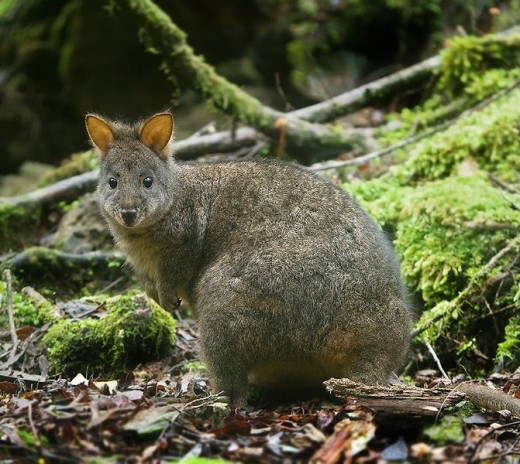Drop bear task force poisoning Tasmania
Tuesday, October 25th, 2011.
 1080 ‘blue carrots’
1080 ‘blue carrots’
.
Six years ago, the Tasmanian Greens tabled their Agricultural and Veterinary Chemicals (Control of Use) Amendment (Ban 1080) Bill 2004 to ban the use of 1080 poison (sodium monofluoroacetate) against native wildlife. But it excluded “persons directly employed with the Fox Task Force, up until the period ending 1 October 2006.”
‘Fox Task Force‘ …what a scam! Talk about dodgy jobs for mates at DPI. All they come up with is shit. It could be Drop Bear shit! They may as well be called it the Drop Bear Task Force and dress ’em up in black special forces attire and give ’em paint guns.
1080 must be banned in Tasmania outright including this fraudulent drop bear mob. I’d like to see an FOI on how much the taxpayer has funded them since they were set up. $10 million? We could have found a cure for the Devil’s face tumor or housed hundreds of homeless youth in Tasmania by now.
Tasmania’s “Department of Primary Industries and Water is the only importer of 1080 into Tasmania and only authorised officers of the Department handle the poison.” So the 1080 buck stps with DPI. DPI’s head needs to show cause, whoever the latest ‘acting’ secretary is! DPI has had so many name changes, ministers and bosses, DPI staff must be running the show. GM Environment was Warren Jones in October, so he can take the can, unless he’s been sacked as well.
According to DPI’s latest annual report, its Environment branch has a mission “to ensure best practice in environmental management and pollution control”…blah blah blah.
Well best practice in environmental management is exercising the precautionary principle, which in lay terms means if you’re not sure don’t intervene. Well ban 1080 until you can deliver a fox to the Hobart Town Hall!
.
.
 Tasmanian native Pademelons killed by 1080 poison
Source: http://www.redbubble.com/people/cradlemountain/art/3160948-why-is-1080-poison-not-good-for-tasmania-and-the-world
Tasmanian native Pademelons killed by 1080 poison
Source: http://www.redbubble.com/people/cradlemountain/art/3160948-why-is-1080-poison-not-good-for-tasmania-and-the-world
.
‘By the year 2000, the Tasmanian Government poisoned 30 million native animals by allowing forest and farming industries to kill all marsupials (other species were sacrificed along with the slaughter).
Here I was collecting bodies and found nine different species affected, dead. This little female wallaby was clasping onto grass and had made a circle in the ground while dying in pain. I could not get the grass out of her little paws.’
 A live and healthy native Tasmanian Pademelon
A live and healthy native Tasmanian Pademelon.
.
1080 is immoral
.
1080 (sodium monofluroacetate) is a cruel and indiscriminate poison used to ‘remove’ unwanted populations of animals.
Banned in most countries, 1080 is still used liberally throughout Australia and New Zealand to control so-called ‘pest’ species, and reduce ‘browsing damage’ caused by native animals on private land. Its use is indiscriminate, which means that it kills not just the target feral animals but every animal in the area that eats off the forest floor.
1080 poison is a slow killer. When ingested (usually through baited food) the animal suffers a prolonged and horrific death. Herbivores take the longest to die – up to 44hrs, while carnivores can take up to 21hrs before finally succumbing to final effects of the poison. The speed of death is dependent on the rate of the animals metabolism.
.
A Slow & Horrific Death
.
Witnesses to the deaths of herbivorous animals, such as macropods, have reported:
“Affected wallabies were sometimes observed sitting hunched up, with heads held shakily just above the ground. Generally they appeared non-alert and ‘sick’, with shivering or shaking forelimbs and unsteady balance. Most individuals then experience convulsions, falling to the ground and lying on their backs and sides, kicking and making running motions with their hind legs before dying. Many individuals also ejaculated shortly before death, and, with others, exuded a white froth from their nostrils and mouth.”
Carnivorous animals such as dingoes, dogs, foxes, and cats become very agitated, as they tremble, convulse and vomit.”
[Source: ‘The World League for Protection of Animals’, ^http://wlpa.org/1080_poison.htm].
Also, 1080 is indiscriminate, it kills all carnivores including Devils, and endangered quolls and dogs.
“Under state poisons legislation, 1080 is a Schedule 7 poison and is available only to specialised or authorised users who have the skills necessary to handle it safely. Under the Agricultural and Veterinary Chemicals Code Regulations 1995, products containing 1080 are also declared to be ‘Restricted Chemical Products’. As such, the products can only be supplied to or used by ‘authorised person(s)’. Individual states set the authorisation criteria taking the APVMA’s and state regulatory requirements into account.
Despite these regulations, poisoning of non-target wildlife and domestic pets is common and farm animal species can also be at risk. In NSW, an estimated 14,000 baits are laid per Rural Land Protection Board per annum, and 2002-2003 figures on 1080 use released by the Tasmanian Government indicated Forestry Tasmania used 23 per cent, farmers 47 per cent, and private forestry 30 per cent. In the same year, the Tasmanian Government also released statistics stating that 97,000 wallabies and brushtail possums had been poisoned by 1080, primarily through baiting programs aimed at targeting browsing and grazing native animals as part of forestry management. Phasing out of 1080 in Tasmanian forests has since commenced.
Canines are particularly susceptible to 1080 and the lethal dose for dogs has been calculated at 0.05mg/kg. Once consumed, it is rapidly absorbed from the gastrointestinal tract, impairing cellular respiration through disruption of the citric acid cycle with resultant CNS anoxia and cardiovascular disturbance. 1080 can also be absorbed from the respiratory tract and through cuts and abrasions.
1080 has no specific antidote and even in animals treated symptomatically, is usually fatal.”
[Source: ‘The Veterinarian’, ^http://www.theveterinarian.com.au/features/article685.asp]
.
1080 poison is as vicious as laying 19th Century steel jaw traps around Hobart parks, or giving kids air rifles to play with at school.
It is incumbent on the public’s trust in the ethics and responsibility of the Tasmanian Government’s Department of Primary Industries, Parks, Water and Environment (etc) to show proof of foxes or else ban 1080 poison outright across Tasmania.
Else it will be some perturbed fox myth that ends up killing Tasmania’s devils, quolls, wallabies, the forester kangaroo, just like the 19th Century myth that Thylacene’s killed farmers’ sheep so deserving their redneck extinction.
The DPI always claims recent physical evidence of foxes. If so, then show recent proof to the public, not old specimen carcasses from a zoo. Show the Tasmanian public also independent zoological proof that using 1080 cannot harm non-target species!
.
Victoria following Tasmania’s backward example
.
‘Authorised persons in Victoria can now purchase 1080 pest animal bait products from accredited retailers or licensed perishable bait manufacturers.
Two categories of 1080 pest animal bait products are now available in Victoria:
- Australian Pesticides and Veterinary Medicines Authority (APVMA) registered 1080 pest animal bait products (‘shelf-stable bait’) such as dry oats and dried meat baits. Retailers of these baits must have Agsafe Guardian 1080 accreditation.
- Perishable 1080 pest animal bait products (‘fresh’ bait) such as carrot and liver, manufactured using 1080 aqueous solution registered with the APVMA for that purpose. These bait products are not registered with the APVMA but are supplied under an APVMA permit. The manufacturer of these bait products is also the retailer. These persons must meet specific training and accreditation requirements and be licensed by the Department of Human Services (DHS).
In order to purchase 1080 pest animal bait products you need to complete a Course in Minimising the Risks in the Use of 1080 Pest Animal Bait Products for Vertebrate Pest Control and obtain a 1080 endorsement to your Agricultural Chemical User Permit (ACUP).
These changes are designed to make it easier for you to purchase 1080 pest animal bait products. They enable users to purchase 1080 pest animal bait products from local accredited retailers during normal business hours, enable a greater range of 1080 pest animal bait products to become available to users, and make the manufacture, supply and use of 1080 pest animal bait products safer.’
[Source: ^http://dpi.vic.gov.au/agriculture/farming-management/chemical-use/agricultural-chemical-use/bait-system, accessed 20111025].
.
South Australia following Tasmania’s backward example
.‘The Controlled Substances (Poisons) Regulations,1996 allows land owners access to 1080 baits (sodium fluoroacetate) for the control of rabbits, foxes and dingoes/ wild dogs on their own property.
The current Label, Directions for Use and Material Safety Data Sheet are reproduced here for each bait product.
The Directions for Use include the following documents:
Record of notification of neighbours before commencement of baiting programs
Checklist to be used when a person first receives baits
Poison laid sign design
Authorisation to use the baits requires the land owner (or their agent nominated in writing) to sign an Approval to Possess 1080 Bait form supplied by a Natural Resources Management officer. Non-compliance with the Directions for Use is an offence under the Controlled Substances Act, 1984 and the Agricultural and Veterinary Products (Control of Use) Act, 2002.
For information on the supply and possession of 1080 bait, contact the Environmental Health Branch, Department of Health on (08) 8226 7117 or (08) 8226 7137.
For information or advice on suspected cases of misuse of 1080 bait products or to report that non-target animals may have been poisoned by 1080, contact PIRSA Biosecurity – Rural Chemicals on (08) 8226 0528.
[Source: ^http://www.pir.sa.gov.au/biosecuritysa/nrm_biosecurity/pest_animal/1080_use_in_sa, accessed 20111025].
.
Further Reading:
.
[1] ‘Another bogus fox claim‘, by Ian Rist, 20100201, Tasmanian Times, ^http://tasmaniantimes.com/index.php?/weblog/article/another-bogus-fox-claim/
[2] ‘Code of Practice for the Use of 1080 for Native Browsing Animal Management‘, Tasmanian Department of Primary Industries, Parks, Water and (by the way) Environment, etc. [3] ‘1080 Poison‘, The World League for Protection of Animals, ^http://www.wlpa.org/1080_poison.htm [4] ‘1080 Poison – the all purpose killer‘, Animal Liberation, ^http://animal-lib.org.au/subjects/culling-and-pest-control/20-1080-poison.html [5] ‘STOP 1080 POISON. New Zealand Must Ban This Poison!‘, 20090425, ^http://www.openureyes.org.nz/blog/?q=node/1359 [6] Indiscriminate Aerial Baiting in New South Wales, ^http://www.dpi.nsw.gov.au/__data/assets/pdf_file/0003/57279/rab-003.pdf [7] Tasmanian Farming – 1080 Poison






